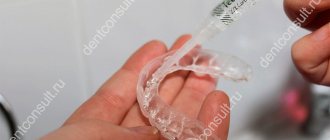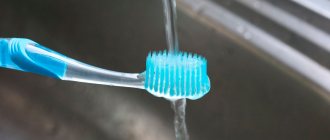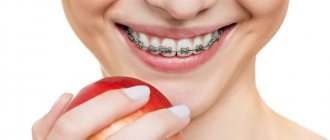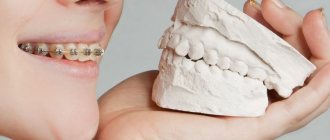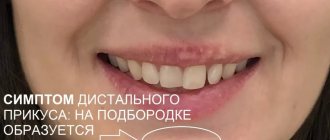Like any medical intervention, correcting the bite has its contraindications, which is why an examination is carried out when preparing to install braces or aligners. There are patients who either cannot or are not recommended to wear braces, but some contraindications can be eliminated - the doctor will give recommendations for this.
There are contraindications to correcting the bite, but they are few.
Absolute contraindications
These are those in which correcting the bite is either impractical or impossible.
- Most of the teeth are missing.
If the chewing teeth on both sides of the upper and lower jaws have been destroyed, removed or missing, then it often makes no sense to correct the position of the remaining ones. When preparing for prosthetics, the doctor will most likely offer an alternative option.
If you have only a few teeth, braces cannot be installed.
- Dystrophic processes in the jaw bone, periodontal disease.
Bone atrophy or thinning are synonymous. The essence of the process is that bone tissue cells are not renewed, the volume of the bone gradually decreases, the roots of the teeth begin to stay in it worse and can become loose. This process requires supervision by a dentist or periodontist, since with due attention to your health, you can slow down the development of the disease and save your teeth. But treatment by an orthodontist, which is accompanied by a strong impact on the roots of the teeth, is no longer carried out.
It is possible to correct a bite if the tissue of the jaw bone is dense and holds the roots of the teeth well.
- Several implants.
Even one implant puts the possibility of correcting the bite into question, since usually when wearing braces or aligners, all teeth move to one degree or another. And if there are several implants, it is impossible to avoid pressure on them. Unlike tooth roots, implants are not able to withstand such a load.
The generally accepted procedure is: first treatment with an orthodontist, and only then installation of implants.
What to put on the upper jaw and what on the lower jaw?
You can place both identical and different jaws on 2 jaws: one type on the upper dentition, and the other on the lower dentition. A simple example. If the upper teeth are more visible when smiling and talking, then aesthetic structures made of ceramics or sapphire are placed on them. Metal ones are installed on the lower teeth, which are almost invisible when opening the mouth. In addition, it will be more affordable, since a metal bracket system is cheaper than an aesthetic one.
The main thing when installing different systems on both jaws is the absence of “technical differences” between them, that is, inconsistencies in parameters. Therefore, it is better to use products from the same manufacturer.
During a direct examination by a specialist, you will be able to find out your exact diagnosis, as well as receive a referral for diagnosis or a treatment plan.
Relative contraindications
These include contraindications that, in different individual cases, may interfere with treatment, or may not have a significant impact on the process.
- Several crowns.
If prosthetics have been performed in the past, then when preparing for treatment you need to pay close attention to the crowns. On what teeth are they installed? What is the condition of the roots of these teeth? Have the crowns and their connection points begun to collapse? Which teeth will be impacted the most and which will move 1-2mm? By answering these questions, your doctor will be able to tell you whether you can wear aligners or braces. Sometimes you need to first have the crown redone and then be treated by an orthodontist.
Crowns, unlike implants, can be moved (but carefully)
- A large number of fillings.
If you have 10 or more teeth filled, the fillings themselves are large (they take up more than 50% of the tooth’s volume), and nerves have been removed in some teeth, this does not mean that the bite cannot be corrected. You just need to more carefully examine all the fillings and find out if they have begun to collapse. The doctor may recommend replacing old fillings. Modern materials for treatment make it possible to save even “dead” teeth.
- Previous tooth restoration.
Veneers are not installed if there are malocclusions, since improper closure of the teeth can lead to destruction and abrasion of the plates. Therefore, there is no point in talking about this technology. However, if in the past one or more teeth were restored using filling material, then, as a rule, this does not prevent you from subsequently wearing aligners or braces - the only question is the quality of the restoration and its condition.
A restored tooth, if its root is not damaged, is not an obstacle to treatment
Pros of braces
Despite the disadvantages of braces, this method of bite correction has significant advantages. These include:
- relatively short treatment time: braces quickly move teeth into the desired position, especially if we are talking about simple metal structures;
- a wide range of indications: many methods can be used only for mild malocclusions, while braces can be used in almost all cases of pathologies that do not require surgical intervention;
- compatibility with other methods: braces can act as an independent method of correction and complement other methods.
Temporary contraindications
These are the ones that are easy to fix. Having identified them during the examination, the orthodontist will give recommendations, and soon after treatment it will be possible to begin correcting the bite.
- Caries.
When wearing any orthodontic structures, plaque forms much faster, and it is more difficult to clean it. Although braces and aligners themselves do not cause caries, attention to hygiene during orthodontic treatment should be much higher. Therefore, removal of all foci of caries, including superficial ones, is an indispensable condition before starting treatment.
- Plaque, tartar.
The reasons are the same as described above. The bite is corrected with perfectly clean teeth. To prepare, it is enough to undergo ultrasonic cleaning (it perfectly removes hard plaque) and air flow (removes soft plaque).
Those who want to correct their bite should get used to more careful dental care. This is a great habit that will help you stay healthy for many years and avoid prosthetics in the future.
- Inflammation of the gums.
Minor inflammation may occur due to accumulated soft plaque. After professional dental hygiene, as a rule, it is enough to follow the doctor’s recommendations for several days (usually the use of local antiseptics) to eliminate the problem.
Types of braces based on location on teeth
In addition to the materials used, bracket systems are classified according to the type of their installation: vestibular and lingual. The first ones are easier to install and are attached to the outside of the teeth, the second - to the inside. Lingual ones are more difficult to install and adaptation to them takes longer, but they are not visible from the outside.
Vestibular braces (external)
Braces located on the visible outer part of the tooth are called vestibular. This type of braces is the most popular among patients. A variety of materials are used to make external braces - metal, ceramic, composite and aluminum oxide. When using this type of braces, there is no negative effect on the teeth. A special orthodontic material is used to attach the structure to the surface of the teeth.
Lingual braces (internal)
For many patients, the aesthetic side of the issue is of great importance: they are interested in installing the system in such a way that it is not visible. The problem is solved by using lingual (internal) braces; they are fixed on the inside of the teeth and those around them cannot see them. If we talk about an aesthetic solution, then this is the best option.
However, there are some inconveniences for the patient when wearing standard internal systems: it is not easy to adapt to them, plus diction suffers.
Not a contraindication
- Childhood.
The whole question is which method of treatment to choose. For younger children, removable aligners are often chosen, and teenagers can wear the same aligners as adults. But you can start correcting your bite immediately after diagnosing the existing problem at any age.
- Older age.
There is no upper age limit. If your teeth are preserved and there is a need to correct their position, you can be treated by an orthodontist at any age.
- General diseases (with very rare exceptions).
Metabolic disorders, asthma, allergies and other systemic diseases almost never interfere with wearing orthodontic structures, since the materials are hypoallergenic, and no surgical intervention (as when installing implants) occurs. If the patient's general condition is satisfactory and he can visit the clinic, then most likely there are no obstacles.
Correcting your bite will not only give you a beautiful smile, but will also prevent many problems with your teeth and the health of your body in general. If you are unsure whether you can undergo orthodontic treatment, please contact your orthodontist and ask all your questions.
More articles on the topic:
- Can veneers correct crooked teeth?
- Reflections ceramic braces: advantages and features
Types of bracket systems by material
Before the advent of modern orthodontic systems and the ability to choose the material from which they are made, many people, even if they wanted to correct their dentition, avoided installing braces. This was explained by the unaesthetic appearance of the metal structure attached to the outside of the teeth.
Today, several types of braces have been developed and used in dental practice, the difference between which is in the material of manufacture and the method of fastening. Among the variety offered, there is always a suitable option.
Metal braces
Systems made from medical steel are the most “democratic” in price, accessible to many. This factor, plus the reliability and durability of the structure, make metal braces popular. However, not everyone is ready to resort to this option due to aesthetic considerations: the smile of the owner of such braces cannot be called attractive. If a charming smile is important to you even while wearing the system, then you should pay attention to other types.
Ceramic braces
Ceramics do not spoil the appearance of teeth, since such braces are almost invisible on the teeth. They are practically no different from tooth enamel, but over time, under the influence of certain drinks (coffee, tea, red wines) and coloring spices, they may become slightly stained. Also, ceramic braces are not sufficiently resistant to mechanical stress.
Plastic braces
The first orthodontic system to compete with metal braces. Aesthetically, plastic looks much better and is almost as invisible. However, there are also disadvantages: low strength, coloring under the influence of food and drink dyes. In this case, you can use colored braces, but this is a matter of taste.
Sapphire braces
The installation of sapphire braces has virtually no effect on your appearance - they are transparent and almost invisible. Made from aluminum oxide. The main and main disadvantage for the widespread use of sapphire systems is their high cost. But the advantages - attractiveness, absence of allergic reactions, high strength and comfort while wearing make this type of system quite popular.
Titanium braces
Absolutely safe biocompatible orthodontic structures. Robust, durable and reliable systems, recommended for allergy sufferers. A relative disadvantage is that they stand out on the surface of the teeth.
Combined braces
Today, this is a successful, popular option in many respects. The doctor can install different types of systems, depending on the situation. For example, if the lower row of teeth is more crooked, metal braces are installed on it, and a more attractive-looking structure is placed on the upper row. In this case, you can also put cheaper metal braces on the side teeth.
In general, you need to know that the appearance of braces does not affect the effectiveness of obtaining the final result. When choosing a system, you should focus on your financial capabilities, aesthetic requirements and individual needs. But in any case, the final choice of a corrective system is made after visiting an orthodontist and receiving a consultation from him.
How are ceramic braces installed?
Before installing braces, the orthodontist performs diagnostics. At the initial stage, a type of braces system is selected that can quickly and carefully act on the teeth, and also corresponds to the wishes of the patient. Hygienic cleaning is carried out so that the enamel is completely free of plaque. This way, the dentist will be able to see changes in the color of the teeth and identify the disease at an early stage. If the patient has hidden caries or other diseases of the oral cavity, then they are treated.
If the teeth and gums are healthy, then the specialist takes a photograph of the patient in profile, full face, and also records the location of the teeth using an X-ray on a panoramic image and teleplanogram (photograph of the skull). These pictures will allow the dentist and the patient to clearly see the problem areas, and after removing the braces, the result of the treatment. Based on this information, the orthodontist draws up a treatment plan and determines the period of wearing braces. The dentist needs some time to analyze the images. The more information the orthodontist has about the patient, the more accurately the doctor can create a treatment plan and predict the progress of teeth straightening.
During the third or fourth visit, the dentist agrees on the final treatment plan and proceeds directly to installing braces. Ceramic plates with a groove for fastening are fixed to each tooth using special glue. Next, the individual braces are pulled together using an arch into a single system. The installation time of braces depends on the complexity of the fastening. On average, the procedure takes two to three hours.
In the first few days, the patient adapts to braces. So that they rub the cheeks and tongue less, they are lubricated with special wax.
During subsequent visits, the specialist will adjust the archwire or replace it with a new one so that the desired pressure is maintained. The duration of wearing braces directly depends on the elasticity of the tissue and the complexity of the clinical case. Compared to metal braces, ceramic braces have a higher frictional force at the junction of the arch and the lock, so they have a gentler effect on the teeth, but the treatment time increases. Despite this, many patients choose the aesthetics and convenience of ceramic braces, since the average time to correct a bite for any system is one to two years.
Contraindications for installing ceramic braces
If there are any diseases, the dentist, after diagnosis, determines the possibility of installing a brace system. In case of any deviations, it is better for the patient to undergo preliminary treatment of teeth and gums, as well as have professional hygienic teeth cleaning. Thus, the installation of braces is contraindicated if the patient has:
- Chalky spots, cracks in enamel, untreated caries;
- Periodontal diseases;
- Multiple fillings, artificial crowns;
- Severe general somatic diseases;
- Allergies to materials used.



